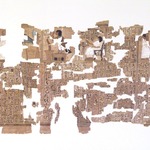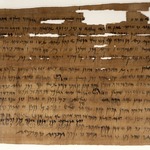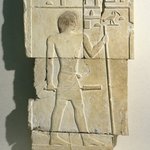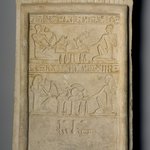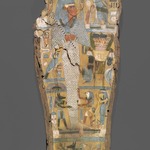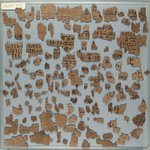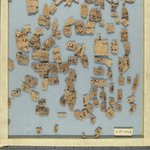
Abbreviated Book of the Dead
Egyptian, Classical, Ancient Near Eastern Art
This vignette comes from a papyrus that belonged to an official named Ankhefenmut. He is shown here in a position of adoration before the god Re-Horakhty. Although scenes depicting private individuals in the presence of a god are known from as early as the Middle Kingdom, they did not become popular until the Ramesside Period.
MEDIUM
Papyrus, ink
DATES
ca. 1070–945 B.C.E.
DYNASTY
Dynasty 21
PERIOD
Third Intermediate Period
DIMENSIONS
Sheet: 8 7/8 x 13 3/8 in. (22.6 x 34 cm)
As mounted: 14 3/8 x 19 1/8 in. (36.5 x 48.5 cm) (show scale)



COLLECTIONS
Egyptian, Classical, Ancient Near Eastern Art
ACCESSION NUMBER
37.1826Ea
CREDIT LINE
Charles Edwin Wilbour Fund
CATALOGUE DESCRIPTION
Papyrus inscribed for a hem-neter of Amun-Re, king of the Gods, Ankhefenmut, son of a man named Wenenefer. To the right is a vignette, rendered as a line drawing, showing the deceased making an offering of incense to a seated Re-Horakhty. To the left, and covering over one half of the papyrus, is an eight-line inscription in Hieratic.
Condition: The various strips of the sheet have separated in many places. The lower right hand corner of the vignette, including the figure of Ankhefenmut from the waist down, is missing.
MUSEUM LOCATION
This item is not on view
CAPTION
Abbreviated Book of the Dead, ca. 1070–945 B.C.E. Papyrus, ink, Sheet: 8 7/8 x 13 3/8 in. (22.6 x 34 cm). Brooklyn Museum, Charles Edwin Wilbour Fund, 37.1826Ea (Photo: Brooklyn Museum, CUR.37.1826Ea_wwg8.jpg)
IMAGE
installation, West Wing gallery 8 installation, CUR.37.1826Ea_wwg8.jpg. Brooklyn Museum photograph, 2006
"CUR" at the beginning of an image file name means that the image was created by a curatorial staff member. These study images may be digital point-and-shoot photographs, when we don\'t yet have high-quality studio photography, or they may be scans of older negatives, slides, or photographic prints, providing historical documentation of the object.
RIGHTS STATEMENT
No known copyright restrictions
This work may be in the public domain in the United States. Works created by United States and non-United States nationals published prior to 1923 are in the public domain, subject to the terms of any applicable treaty or agreement.
You may download and use Brooklyn Museum images of this work. Please include caption information from this page and credit the Brooklyn Museum. If you need a high resolution file, please fill out our online application form (charges apply).
The Museum does not warrant that the use of this work will not infringe on the rights of third parties, such as artists or artists' heirs holding the rights to the work. It is your responsibility to determine and satisfy copyright or other use restrictions before copying, transmitting, or making other use of protected items beyond that allowed by "fair use," as such term is understood under the United States Copyright Act.
The Brooklyn Museum makes no representations or warranties with respect to the application or terms of any international agreement governing copyright protection in the United States for works created by foreign nationals.
For further information about copyright, we recommend resources at the United States Library of Congress, Cornell University, Copyright and Cultural Institutions: Guidelines for U.S. Libraries, Archives, and Museums, and Copyright Watch.
For more information about the Museum's rights project, including how rights types are assigned, please see our blog posts on copyright.
If you have any information regarding this work and rights to it, please contact copyright@brooklynmuseum.org.
RECORD COMPLETENESS
Not every record you will find here is complete. More information is available for some works than for others, and some entries have been updated more recently. Records are frequently reviewed and revised, and we welcome any additional information you might have.









